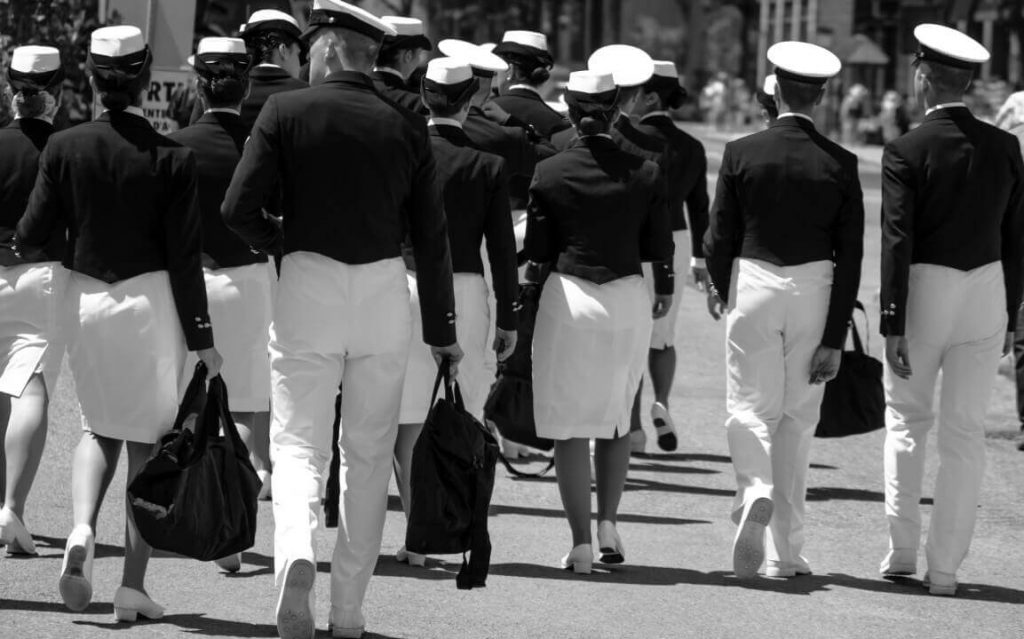This is the leadership story of David Marquet, commander of the nuclear submarine Santa Fe, who realized during a simple drill, that having one point of command was not only limiting the efficiency of operations of the sub, it was downright dangerous.
David, who served in the US Submarine Force for 28 years. was assigned command of the nuclear submarine, USS Santa Fe, which at the time, was suffering from low morale, low performance, and low crew retention. By rejecting the classic leader/follower model, he transformed the performance of the Santa Fe from the worst in the fleet to the best. Read more about his amazing journey and the creation of Intent-Based leadership style.
Inspiration Strikes
David was a teenager when he first discovered his passion for leadership. He was spending the summer with his grandparents in Pittsburgh. One day, he wandered down the street to the local library. He discovered a series of books—History of United States Naval Operations in World War II by Samuel Eliot Morison. He returned to the library each day until he had devoured each of the 15 volumes—more than 6,500 pages in total. David’s dream came alive; he set his sights on one day becoming captain of a Navy vessel on which people thrived.
Embarking on the Journey
In 1981, David graduated top of his class from the U.S. Naval Academy—an institute renowned for developing “leaders to serve the nation.” Thereafter, he joined the submarine force. Along his journey, one thing bothered him: The traditional leader-follower model. Used by the Navy and most companies around the world, the goal of leader-follower is to influence people to comply, not think. David experienced first-hand how this practice makes people feel marginalized. He knew in his gut that there had to be a better way. He’d soon discover that to prove his theory he’d have to break some rules. As engineer officer aboard the USS Will Rogers (SSBN-659), a nuclear powered ballistic missile submarine, David tried empowering his team. He provided broad guidance, giving the team intent rather than orders. It was … a disaster. His team made poor decisions that led to errors. He had to stop and revert to the traditional leader-follower method.
Taking Command
Ultimately, David was selected to captain the USS Olympia (SSN-717), a nuclear powered attack submarine. He studied for over a year to take command, understanding on a deep level every detail of how that submarine operated. Unexpectedly, David was diverted to take command of the USS Santa Fe (SSN-763) when its captain quit. Santa Fe was the worst performing submarine in the fleet and a different type of submarine that he knew little about.
Troubled Waters
Less than a month later the Santa Fe was running a simple drill to simulate a fault with the reactor. In this scenario, propulsion is shifted from the main engines to a smaller, electric propulsion motor. The captain ordered, “ahead two-thirds.” The officer on deck repeated the order, “ahead two-thirds.” Nothing happened. Captain Marquet noticed the helmsman who was to execute the order looked unsettled. When asked what the problem was, the helmsman pointed out that there was no two-thirds in the electric propulsion mode unlike all his previous submarines. When asked, the officer on deck said he repeated the command knowing it was wrong. David realized that the leader-follower environment meant his crew would do anything he said—even if it was wrong. That could be catastrophic. He decided to try Intent-Based Leadership again.
Turning the Ship Around
Captain Marquet began treating his crew as leaders, not followers, and giving control, not taking control. It wasn’t long before operations took a dramatic turn. Santa Fe went from “worst to first,” achieving the highest retention and operational standings in the Navy. When Stephen R. Covey spent time aboard the Santa Fe, he referred to it as the most empowering organization he’d ever seen. He wrote about Captain Marquet’s leadership practices in his book, The 8th Habit.
Captain Marquet realized that all his training about leadership was about getting people to do what they were told, and that was not what he needed in demanding and critical situations. What he needed was for people to think. He needed to figure out how to get people thinking. Eventually, he realized that he can only control himself, and the thing that he could do is stop telling people what to do. As he leaned back and gave others space, they can lean forward. David developed his simple “I intend to” leadership phrase. Meaning, his instruction to his team was not to come up with questions and problems without solutions. Instead, he told his team that they could describe problems, but then say at the end, “And here’s what I intend to do.” Over time this approach became unbelievably successful.
After Captain Marquet’s departure from the USS Santa Fe, it continued to win awards and promote more officers and enlisted men to positions of increased responsibility than any other submarine—including ten subsequent submarine captains. Captain Marquet retired from the Navy in 2009 and is now the author of Turn the Ship Around! A True Story of Turning Followers Into Leaders (link to the book is below).
Thanks,
Andreas von der Heydt

